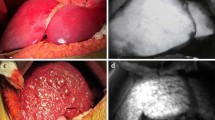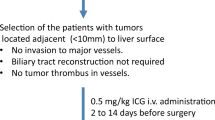Abstract
Background
In malignant hepatic neoplasm, anatomic resection could improve survival and limit complications from hepatectomy. Our purpose was to develop an intraoperative method for identifying segment and subsegment of the liver with high-sensitivity near-infrared fluorescence imaging.
Methods
The subjects were 35 patients with hepatic malignant liver disease who received hepatectomy in 2006. The segments of liver method of identification that used infrared observation camera system termed Photo Dynamic Eye-2 (PDE-2) with indocianine green (ICG) for the patient with malignant liver tumor (hepatocellular carcinoma: 13 cases; metastatic liver cancer: 18 cases; intrahepatic cholangio carcinoma: 4 cases) were performed before liver resection.
Results
Although greenish stain of the liver surface after the injection of ICG via portal vein is not visible clearly without infrared observation camera system PDE-2, 1 minute after injection of ICG with fluorescent using infrared observation camera system PDE-2, demarcation of liver segment and subsegment was clearly detected. Ten minutes after injection of ICG with fluorescent using infrared observation camera system PDE-2, fluorescence of liver subsegment remained. Stained subsegment and segment of liver were identifiable in 33 (94.3%) of the 35 patients. There were no complications or side-effects related to the injection of patent blue dye.
Conclusion
We demonstrated here that near-infrared fluorescence imaging system is a novel and reliable intraoperative technique to identify hepatic segment and subsegment for anatomical hepatic resection.




Similar content being viewed by others
References
Makuuchi M, Hasegawa H, Yamazaki S (1985) Ultrasonically guided subsegmentectomy. Surg Gynecol Obset 161:346–350
Makino I, Chijiiwa K, Kondo K et al (2005) Prognostic benefit of selective portal vein occlusion during hepatic resection for hepatocellular carcinoma. Surgery 137:626–631
Hasegawa K, Kokudo N, Imamura H et al (2005) Prognostic impact of anatomic resection for hepatocellular carcinoma. Ann Surg 242:252–259
Billingsley KG, Jarnagin WR, Fong Y et al (1998) Segment-oriented hepatic resection in the management of malignant neoplasms of the liver. J Am Coll Surg 187:471–481
Sakairi T, Makuuchi M (1991) Identification of the intersegmental or subsegmental plane in the liver with a surgical clip. Surgery 110:903–904
Kitai T, Inamoto T, Miwa M et al (2005) Fluorescence navigation with indocyanine green for detecting sentinel lymph nodes in breast cancer. Breast Cancer 12:211–215
Motomura K, Inaji H, Komoike Y et al (1999) Sentinel node biopsy guided by indocyanine green dye in breast cancer patients. Jpn J Clin Oncol 29:604–607
Nimura H, Narimiya N, Mitsumori N et al (2004) Infrared ray electronic endoscopy combined with indocyanine green injection for detection of sentinel nodes of patients with gastric cancer. Br J Surg 91:575–579
Ishikawa K, Yasuda K, Shiromizu A et al (2007) Laparoscopic sentinel node navigation achieved by infrared ray electronic endoscopy system in patients with gastric cancer. Surg Endosc 21:1131–1134
Ito N, Fukuta M, Tokushima T et al (2004) Sentinel node navigation surgery using indocyanine green in patients with lung cancer. Surg Today 34:581–585
Soltesz EG, Kim S, Laurence RG et al (2005) Intraoperative sentinel lymph node mapping of the lung using near-infrared fluorescent quantum dots. Ann Thorac Surg 79:269–277
Parungo CP, Ohnishi S, Kim SW et al (2005) Intraoperative identification of esophageal sentinel lymph nodes with near-infrared fluorescence imaging. J Thorac Cardiovasc Surg 129:844–850
Taggart DP, Choudhary B, Anastasiadis K et al (2003) Preliminary experience with a novel intraoperative fluorescence imaging technique to evaluate the patency of bypass grafts in total arterial revascularization. Ann Thorac Surg 75:870–873
Detter C, Russ D, Iffland A et al (2002) Near-infrared fluorescence coronary angiography: a new noninvasive technology for intraoperative graft patency control. Heart Surg Forum 5:364–369
Rubens FD, Ruel M, Fremes SE (2002) A new and simplified method for coronary and graft imaging during CABG. Heart Surg Forum 5:141–144
Sekijima M, Tojimbara T, Sato S et al (2004) An intraoperative fluorescent imaging system in organ transplantation. Transplant Proc 36:2188–2190
Raabe A, Beck J, Gerlach R et al (2003) Near-infrared indocyanine green video angiography: a new method for intraoperative assessment of vascular flow. Neurosurgery 52:132–139
Kuroiwa T, Kajimoto Y, Ohta T (2001) Development and clinical application of near-infrared surgical microscope: preliminary report. Minim Invasive Neurosurg 44:240–242
Tanaka E, Choi HS, Fujii H et al (2006) Image-guided oncologic surgery using invisible light: completed pre-clinical development for sentinel lymph node mapping. Ann Surg Oncol 13:1671–1681
Author information
Authors and Affiliations
Corresponding author
Rights and permissions
About this article
Cite this article
Aoki, T., Yasuda, D., Shimizu, Y. et al. Image-Guided Liver Mapping Using Fluorescence Navigation System with Indocyanine Green for Anatomical Hepatic Resection. World J Surg 32, 1763–1767 (2008). https://doi.org/10.1007/s00268-008-9620-y
Published:
Issue Date:
DOI: https://doi.org/10.1007/s00268-008-9620-y




